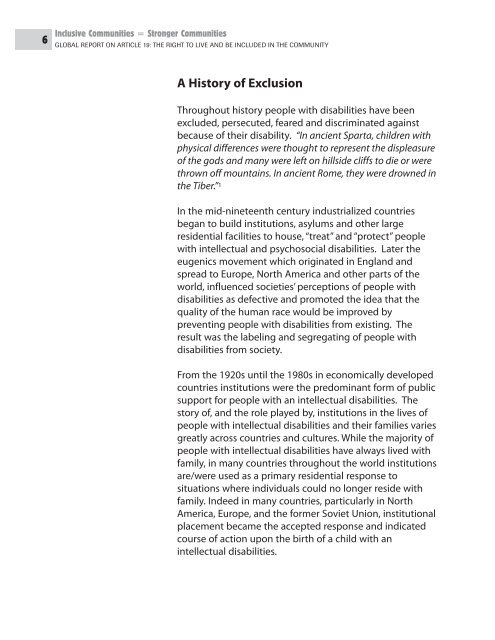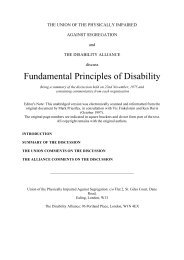Global-Report-Living-Colour-dr2-2
Global-Report-Living-Colour-dr2-2
Global-Report-Living-Colour-dr2-2
You also want an ePaper? Increase the reach of your titles
YUMPU automatically turns print PDFs into web optimized ePapers that Google loves.
6<br />
Inclusive Communities = Stronger Communities<br />
GLOBAL REPORT ON ARTICLE 19: THE RIGHT TO LIVE AND BE INCLUDED IN THE COMMUNITY<br />
A History of Exclusion<br />
Throughout history people with disabilities have been<br />
excluded, persecuted, feared and discriminated against<br />
because of their disability. “In ancient Sparta, children with<br />
physical differences were thought to represent the displeasure<br />
of the gods and many were left on hillside cliffs to die or were<br />
thrown off mountains. In ancient Rome, they were drowned in<br />
the Tiber.” 1<br />
In the mid-nineteenth century industrialized countries<br />
began to build institutions, asylums and other large<br />
residential facilities to house, “treat” and “protect” people<br />
with intellectual and psychosocial disabilities. Later the<br />
eugenics movement which originated in England and<br />
spread to Europe, North America and other parts of the<br />
world, influenced societies’ perceptions of people with<br />
disabilities as defective and promoted the idea that the<br />
quality of the human race would be improved by<br />
preventing people with disabilities from existing. The<br />
result was the labeling and segregating of people with<br />
disabilities from society.<br />
From the 1920s until the 1980s in economically developed<br />
countries institutions were the predominant form of public<br />
support for people with an intellectual disabilities. The<br />
story of, and the role played by, institutions in the lives of<br />
people with intellectual disabilities and their families varies<br />
greatly across countries and cultures. While the majority of<br />
people with intellectual disabilities have always lived with<br />
family, in many countries throughout the world institutions<br />
are/were used as a primary residential response to<br />
situations where individuals could no longer reside with<br />
family. Indeed in many countries, particularly in North<br />
America, Europe, and the former Soviet Union, institutional<br />
placement became the accepted response and indicated<br />
course of action upon the birth of a child with an<br />
intellectual disabilities.



